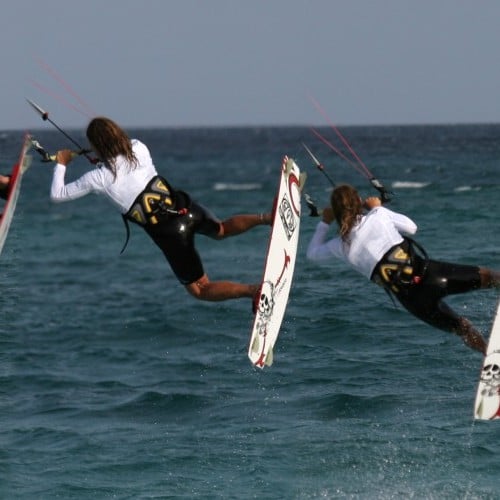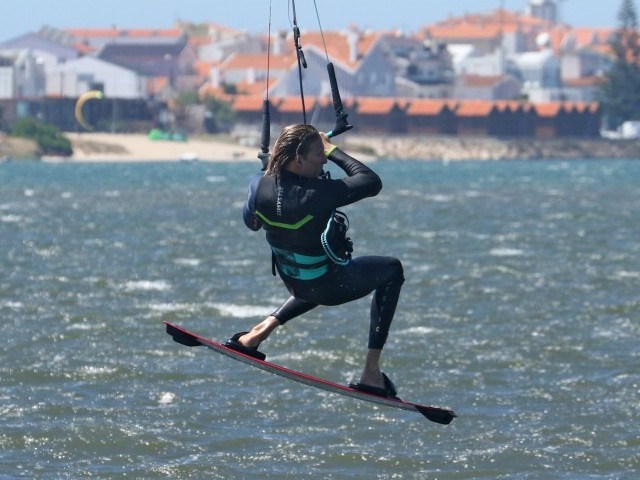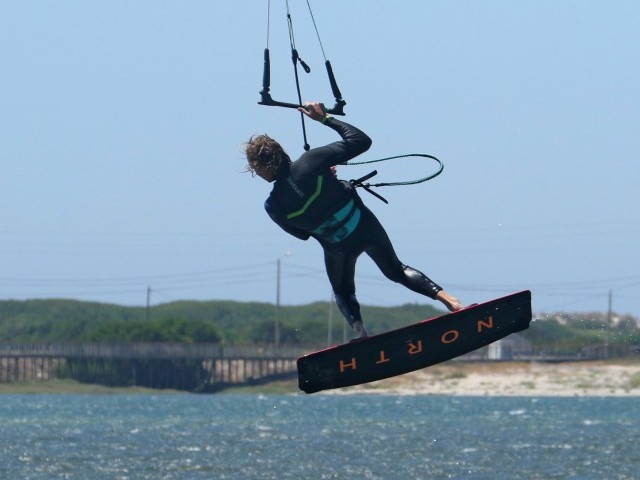
Back Loop Kite Loop
Technique / Intermediate
Introduction
Ruben Lenten has pretty much made this move his-own, which is just as well because it could do with a bit of a revival. This is very much an advanced move and done well looks phenomenal (see above). Back in the day the back loop kite loop separated the men and women from the boys and girls. Obviously the kids have got one up on us now but without getting too sentimental, and not wanting to put anyone off, you generally have to suffer a bit before getting this move ironed out in powered conditions.
Back looping well is a must before you go attempting this, as in essence it’s all about controlling your rotation. If you can pull off a decent pop back loop that will help too, as you will have started to rotate around an axis that is not vertical. If you’ve tried hooked in kite loops it will certainly help your confidence, although V regs are at no disadvantage.
The Classroom
You will be putting your kite through some power so once again you’ll need plenty of space downwind, in front and behind you (the kite will be pulling you back), and remember if it’s blowing onshore get out back. If you are fond of sailing in flat lagoons (or harbours) make sure that there is plenty of depth to the water. In short if there is nothing to hit but water you’ll be fine.
Kit
Although small kites definitely turn quicker, the winds and gusts in which we use them are more punishing, and the ensuing wipe-outs considerably harder. The point here being that as you are hooked in you can’t really let go. Therefore leaning in fairly light winds with a biggish kite is a good place to start. Once you’ve got it sussed it should not be rocket science to step it up a gear or two. If you own an impact vest, you might as well wear it.
What’s the Idea?
The general aim of your first back loop kite loop attempt is to execute a smallish jump (try starting with the kite at 11:30 or 12:30), with a controlled back loop and then when you are half way round your rotation, to pull like stink on your back hand and back loop the kite. The resultant pull from the kite should then pull you around the rest of your rotation and you’ll land perfectly down wind.
By “controlled backloop” we mean an aerial back loop in which you rotate nearly all of the way whilst airborne. As opposed to an upwind 180, followed by an aerial 180, where you carve all the way upwind with bent legs for a spinning back loop under the kite. This second variety will result in you over-rotating when the kite loops. By sailing across the wind and extending off the back leg on take off you will slow your rotation down. Your leading shoulder should be rising up above your back shoulder, rather than twisting round into the wind. This method of extension is similar to the Air Gibe.
The difference between this and a normal backloop is that you have no intention to redirect the kite. It will loop from behind you, where you left it. This means that you need to send the kite quite hard as in a jump or air gibe, to give yourself enough height and time when the kite pulls from above, but also because if you drift the kite slowly back, it will end up so far behind you and so near the water, that the kite will crash, and if it doesn’t you’ll have no height to get your legs underneath you for the landing.
Finally although it may well seem sensible to approach with as little speed as possible, speed is once again our friend. With some speed the yank from the kite will seem far less violent. Think 0-30 or 20-30!
Following Sequence 1
- Pic 1. Knowing that the coast is clear Karine approaches with good speed and her kite at 11:30. She has also moved her back hand further down the bar for better leverage when she loops the kite.
- Pic 2. She now sends the kite and edges hard. As the kite starts to move she drops her hips low and moves them back. This extends her front leg whilst allowing her to bend the back back leg whilst still driving through her back heel. Note how she is not trying to look upwind and over her shoulder. This is to prevent over rotating.
- Pic 3. As the kite pulls her up Karine extends her back leg, carves harder upwind to initiate the back loop and keeps the bar sheeted in.
- Pic 4. Even rising into the air Karine has kept her head square to her shoulders. She continues to pull on the back hand which keeps her slow backloop in motion.
- Pic 5. Now facing upwind Karine pulls like Billy’O. Her right (back) elbow comes down towards her waist.
- Pic 6. . She also allows her left (front) arm to extend. It is tempting to hold on tight and keep both arms in, but this will only stop the kite looping.
- Pic 7. As the kite loops it pulls Karine upwards and further around her rotation.
- Pic 8. She now tries to bring her legs back underneath her by bending her knees.
- Pics 9, 10 & 11. The kite now rises up again and Karine starts to drop down under it. She begins to spot her landing and stops pulling on the back hand (a double may be a tad adventurous). If she were to feel off balance, she could now let go with her back hand for stability.
- Pics 12 & 13. Whilst dropping, Karine sets her board for a fast downwind landing. She keeps the bar fully in as there may well be some slack in the lines, and starts to redirect the kite forwards.
- Pic 14. Landing tail first with soft knees, Karine sighs with relief and carves back onto her edge.
Top Tips
This move is all about commitment. If you enter with fair speed and really go for it’ll work.
Once it’s time to initiate the kite loop, you should pull harder hard as is humanly possible. Even if the kite turns quickly, as long as you keep the bar sheeted in you’ll get a fair yank.
Don’t stop pulling once you’ve committed. Ironically a complete loop is softer on the body and kite than a diving kite.
Imagine on take off that you are leaning against a door. Your aim is to jump up into the top corner in front of, and above your leading shoulder. Don’t try and spin into the wind.
Once you’re comfortable, try adding more power and more height.
This technique article was in Issue 3 of IKSURFMAG.
Related
By Christian and Karine
Christian and Karine have been working together as a coaching team, running improver to advanced kitesurfing clinics since 2003.





















